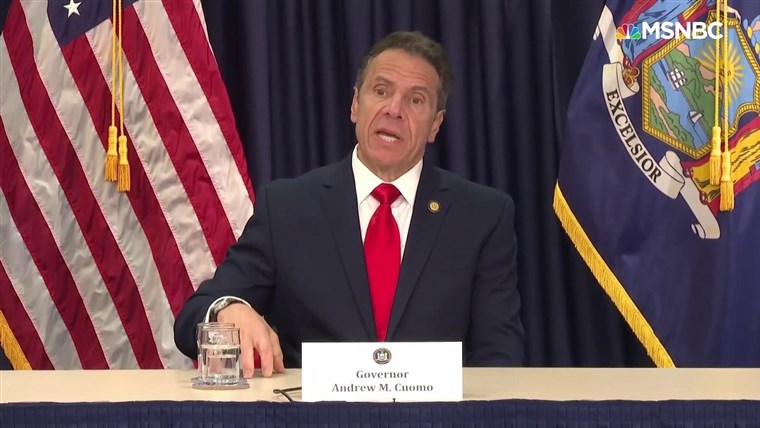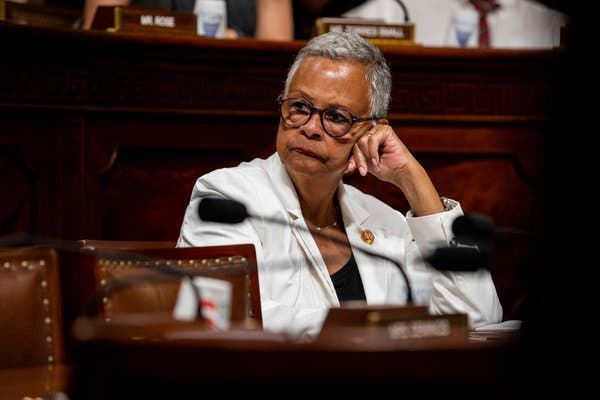The coronavirus pandemic will cost states hundreds of billions of dollars in revenue in the upcoming fiscal year, according to an NBC News survey of 33 states and Washington, D.C.
With most states starting their new fiscal year early this summer, the projections in many cases will serve as the basis for severe budget cuts states may have to make if massive federal government aid doesn’t come soon. Though, the nature of the crisis makes forecasting the future incredibly difficult, officials said.
Every state that responded to the NBC News survey reported it faces a revenue loss — that includes large states and small across the country, some red and others blue — although not every one said it’d be forced to make budget cuts soon.
“This is an unprecedented occurrence in American history and arguably world history, at least in modern history,” said Louisiana Commissioner of Administration Jay Dardenne. “So there’s no playbook. There’s nothing to look at. And there’s nothing to benchmark for this.”
NBC News reached out to the top budget officials in all 50 states asking how much revenue they were projecting would be lost as a result of the coronavirus outbreak, what kind of budget shortfall they are facing and what, if any, cuts will be necessary.
Twenty-seven states and Washington, D.C., responded with either initial totals for how much they’ve lost, projections for the upcoming fiscal year or budget cuts they are considering. Eight states did not respond but have since released that information publicly. The remaining 16 states either did not respond or have not released such information publicly, though officials in some of those states have openly discussed facing revenue shortfalls in the billions.
The revenue declines reach every aspect of states’ sources for spending money. New York is projecting its biggest dip will come from a nearly $12 billion hit to sales and use taxes. In Alaska and Oklahoma, the collapsing oil prices are projected to take a huge toll, while in Arizona, individual income taxes are projected to be at the heart of the state’s losses.
Dardenne told NBC News that trying model expected losses is an almost “impossible chore” and noted that two of his states’ top economists acknowledged their initial projections of $1 billion in lost revenue may need to be revised in a big way later this year.
Virginia Secretary of Finance Aubrey Layne, whose state is projecting $3 billion in losses through fiscal year 2022, will be re-forecasting in the coming weeks. No economist, he said, has a crystal ball for this crisis.
“Models are most accurate when describing how the economy and revenues normally behave,” Mark Quasney, a South Dakota state economist, told NBC News. “This is not a normal time, so estimates are highly unreliable and volatile.”
The initial projections show eye-popping results. Earlier this month, California projected a dip of more than $41 billion in revenue through fiscal year 2021 with a budget deficit of about $54.3 billion — nearly three times the size of its rainy day fund. Though, that hole is smaller, percentage-wise, than deficits California faced in 2003 and 2009, which the state attributed to “prudent fiscal management and strong economic recovery since 2011.”
California Gov. Gavin Newsom, a Democrat, told CNN’s “State of the Union” on Sunday that “none” of the budget issues his state is facing is a result of any pre-existing financial conditions.
“We’re not looking for charity, we’re not looking for handouts,” Newsom said, adding that states “are facing unprecedented budgetary stress. It is incumbent upon the federal government to help support these states through this difficult time.”
Newsom added the funding is “not a red issue or a blue issue.”
“This is impacting every state in America,” he said.
In New York, the state the coronavirus outbreak hit hardest, more than $31 billion in lost revenue is projected by the end of the next fiscal year. Over the next four years, the state projects that total to hit about $61 billion.
Already, New York has planned to cut about $10 billion in spending as Gov. Andrew Cuomo, a Democrat, said his state needs the federal government to provide that $61 billion directly in emergency relief funding.
On a per capita basis, states projected to see among the largest decreases in revenue include the two aforementioned states as well as Alaska, New Jersey, New Mexico and Wyoming.
Some of the nation’s largest states have yet to finalize their projections. But officials in Florida and Texas have said they expect their states to be “short billions and billions” in revenue while leaders in states like Georgia and Oregon have directed state agencies to come up with a plan for cutting their budgets by more than $3.5 billion and $1.8 billion, respectively.
Elsewhere, officials in Delaware, North Carolina and Illinois are faced with the prospect of budget cuts ranging from $550 million to $7.4 billion.
Unlike the federal government, states cannot run a deficit.
Such spending reductions would hit health care and education particularly hard. That was previewed in Ohio last week as Gov. Mike DeWine, presented with a revenue loss of more than $775 million, cut that amount of money from his state’s budget. Much of it hit both K-12 and higher education, as well as health care spending such as Medicaid.
Like many states facing economic calamity, Ohio has a rainy day fund. But the uncertain economic future led DeWine to opt against drawing from it. That money may be needed even more later on, he said.
Nationwide, those rainy day funds won’t be nearly enough to cover the downfall. In its projection, the Federation of Tax Administrators found that state governments will take a $152 billion blow between April and June — far outpacing the $90 billion state governments had in reserve as of 2019. That’s without taking into account the additional losses that are anticipated in the upcoming fiscal year.
“This is going to be more than a rainy day,” Arizona Gov. Doug Ducey, a Republican, told KTAR in an interview Tuesday. His state projects a shortfall of anywhere from $600 million to $1.6 billion through the next fiscal year.
Budget officials across the country who spoke with NBC News expressed hope that Congress will pass additional funding so they can avoid massive cuts. During the last economic downturn in 2009, the slow recovery for state and local governments put a drag on how quick the overall economy was able to emerge from the Great Recession.
Last week, House Democrats passed a plan to provide $500 billion in funding to the states. That’s equal to the total Maryland Gov. Larry Hogan, a Republican and chair of the National Governors Association, and Cuomo, the NGA vice chair, have called for.
“Each day that Congress fails to act, states are being forced to make cuts that will devastate the essential services the American people rely on and destroy the economic recovery before it even gets off the ground,” Hogan and Cuomo said in a joint statement. “This is not a red state and blue state crisis. This is a red white and blue pandemic.”
Republican senators are split over the path forward for state relief — both on whether more money should be provided and if existing appropriated funds for states can be made more flexible. States received $150 billion in emergency funding in earlier COVID-19 legislation, but the Treasury Department said that money can only be used to cover costs directly associated with the pandemic, not on filling budget gaps.
President Donald Trump has claimed all the states that need help are run by Democrats, while Senate Majority Leader Mitch McConnell, R-Ky., initially suggested he’d prefer states go bankrupt.
McConnell later changed course and said the only way he would be OK with more money to the states is if Congress removed legal liability for companies that bring workers back amid the coronavirus outbreak. Trump has backed that call, adding he also wants to see “the elimination of sanctuary cities” and other tax cuts.
McConnell’s own state is projecting a revenue shortfall of nearly $1.3 billion through the upcoming fiscal year; the state’s annual budget is about $12 billion. As Kentucky State Budget Director John Hicks wrote in a state economic report late last month, “The national economic outlook for the third quarterly report of FY20 is undoubtedly the most abrupt quarterly change ever encountered.”



